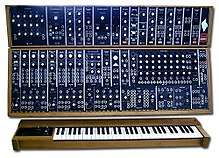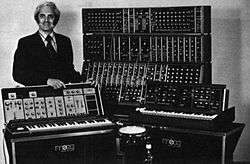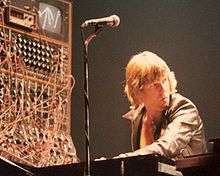Moog synthesizer
The Moog synthesizer is a synthesizer developed by the American engineer Robert Moog. Moog debuted it in 1964, and Moog's company R.A. Moog Co. (later known as Moog Music) produced numerous models from 1965 to 1980.[1] It was the first commercial synthesizer, and is credited with creating the analog synthesizer as it is known today.
| Moog synthesizer | |
|---|---|
 A 1975 Moog Modular 55 system | |
| Manufacturer | R.A. Moog Co |
| Dates | 1965 — 1980 |
| Technical specifications | |
| Oscillator | VCO |
| Synthesis type | Subtractive |
| Filter | VCF |
| Input/output | |
By 1963, Moog had been designing and selling theremins for several years. He began developing the Moog synthesizer in response to demand for more practical and affordable electronic music equipment, guided by suggestions and requests from composers including Herb Deutsch, Richard Teitelbaum, Vladimir Ussachevsky, and Wendy Carlos.
The synthesizer consists of separate modules — such as oscillators, amplifiers, envelope generators, filters, noise generators, ring modulators, triggers and mixers — which create and shape sounds, and can be connected via patch cords. It can be played using controllers including keyboards, joysticks, pedals, and ribbon controllers. Its oscillators can produce waveforms of different timbres, which can be modulated and filtered to produce more combinations of sounds (subtractive synthesis).
Moog's principal innovation was to use voltage to control pitch via a voltage-controlled oscillator. The synthesizer also introduced fundamental synthesizer concepts such as modularity and envelope generation. It was brought to the mainstream by Switched-On Bach (1968), a bestselling album of Bach compositions arranged for Moog synthesizer by Wendy Carlos. In the late 1960s, the Moog was adopted by rock and pop acts including the Doors, the Grateful Dead, the Rolling Stones, and the Beatles. At its height of popularity, it was a staple of 1970s progressive rock, used by acts including Yes, Tangerine Dream, and Emerson, Lake & Palmer. In 1970, Moog Music released a portable, self-contained model, the Minimoog.
Development

In the early 1960s, electronic music technology was impractical and used mainly by experimental composers to create music with little mainstream appeal.[2] In 1963, American engineer Robert Moog, who designed and sold theremins,[3] met composer Herb Deutsch at a New York State School Music Association trade fair. Deutsch had been making electronic music using a theremin, tape recorder, and single-pitch oscillator, a time-consuming process that involved splicing tape. Recognizing the need for more practical and sophisticated equipment, Moog and Deutsch discussed the notion of a "portable electronic music studio".[4]
Moog received a grant of $16,000 from the New York State Small Business Association and began work in Trumansburg, New York.[4] At the time, synthesizer-like instruments filled rooms;[5] Moog hoped to build a more compact instrument that would appeal to musicians.[6] Learning from his experience building a prohibitively expensive guitar amplifier, he believed that practicality and affordability were the most important parameters.[6]
Previous synthesizers, such as the RCA Mark II, had created sound from hundreds of vacuum tubes.[7] Instead, Moog used recently available silicon transistors — specifically a transistor with an exponential relationship between input voltage and output current. With this, he created the voltage-controlled oscillator (VCO), which generated a waveform whose pitch could be adjusted by changing the voltage. Moog designed his synthesizer around a standard of one volt per octave. Similarly, he used voltage to control loudness with voltage-controlled amplifiers (VCAs).[4]
When Deutsch visited, he found Moog working on a prototype with two VCOs and a VCA. Having two VCOs was significant; as the VCOs themselves could output voltage, one could be used to modulate the output of another, creating effects such as vibrato and tremolo.[4] According to Moog, Deutsch "went through the roof" and immediately began making music with the prototype, attracting the interest of passersby: "They would stand there, they’d listen and they’d shake their heads. You know they’d listen again—what is this weird shit coming out of the basement?"[4]

In mid-1964, Moog and Deutsch demonstrated the synthesizer at the electronic music studio at the University of Toronto.[4] After the presentation impressed the composers, Moog was invited by the Audio Engineering Society to present at their annual convention in New York that October.[5] Though he had not planned to sell synthesizers there, Moog took "two or three" orders at the show; the choreographer Alwin Nikolais became the first person to purchase a commercially made Moog synthesizer.[4] Moog constructed synthesizers to order.[7] The first order for a complete Moog synthesizer, for which Moog had to design a keyboard and cabinet, came from composer Eric Siday.[4]
Moog refined the synthesizer in response to requests from musicians and composers.[8] For example, after Deutsch suggested Moog find a way to fade notes in and out, Moog invented an envelope module, using a doorbell button as a prototype.[4] At the suggestion of composer Gustav Ciamaga, Moog developed a filter module, a means of removing frequencies from waveforms.[4] His first filter design created a sound similar to a wah-wah pedal; he later developed his ladder filter, "the most distinctive feature of the Moog sound".[4] It was the only item in the synthesizer design that Moog patented, granted on October 28, 1969.[4] Further developments were driven by suggestions from musicians including Richard Teitelbaum, Vladimir Ussachevsky, and Wendy Carlos;[8] it was Carlos who suggested the first touch-sensitive keyboard, portamento control, and filter bank, which became standard features.[4]
Moog initially avoided the word synthesizer, as it was associated with the RCA synthesizer, and instead described his invention as a "system" of "electronic music modules". The classical meaning of "to synthesize" is to assemble a whole out of parts. After many debates, Moog eventually told composer Reynold Weidenaar: "It’s a synthesizer and that's what it does and we're just going to have to go with it."[4] Moog used the word synthesizer in print for the first time in 1966. By the 1970s, "synthesizer" had become the standard term for such instruments.[4]
There was also debate as to the role of the keyboard in synthesizers. Some, such as composer Vladimir Ussachevsky and Moog's competitor Don Buchla, felt that keyboards were restrictive. However, Moog recognized that most customers wanted keyboards and found it helped make the instrument approachable.[4] He said: "Whenever someone wanted to take a picture, for some reason or other it looks good if you’re playing a keyboard. People understand that then you're making music."[4] He also developed alternative controllers, such as the ribbon controller, which allows users to control pitch similarly to moving a finger along a violin string.[4]
Moog had pursued the development of his synthesizer as a hobby, and said the experience was "like in these amusement parks where you’re sort of going down and you’re not quite in control. You know you're not going to get hurt too badly because nobody would let you do that, but you’re not quite in control. That’s the way it was."[4] He said he was "not a businessman at the time ... I literally didn’t know what a balance sheet was."[4] By the end of the 1960s, most of the Moog modules had been finalized, and remained mostly unchanged until Moog Music ceased trading in the 1980s.[2]
Components

The Moog synthesizer consists of separate modules – such as oscillators, amplifiers, envelope generators, filters, noise generators, ring modulators, triggers and mixers – which can be connected in a variety of ways via patch cords.[7][4] The modules can also be used to control each other.[4] The synthesizer can be played using controllers including keyboards, joysticks, pedals, and ribbon controllers.[7]
The oscillators can produce different waveforms with different tones and overtones, such as a "bright, full, brassy" sawtooth wave, a thinner, flute-like triangle wave, a "nasal, reedy" pulse wave, and a "whistle-like" sine wave.[4] These waveforms can be modulated and filtered to produce more combinations of sounds (subtractive synthesis).[4] The oscillators were difficult to keep in tune, and small temperature changes would cause them to drift rapidly.[2] As Moog's early customers were more interested in creating experimental music than playing conventional melodies, Moog did not consider keeping them stable a priority.[7]
The Moog resonant low-pass filter is particularly distinctive, with a "rich", "juicy", "fat" sound.[4] The filter, based on pairs of transistors connected by capacitors arranged in a ladder-like layout, attenuates frequencies above a level set by the user and boosts the frequencies around the cut-off frequency.[4] When overdriven, the filter produces a rich distortion described as "the Moog sound".[4]
The Moog does not produce sound until a workable combination of modules had been connected, and the open system allowed users to conduct "pointless patch experiments" that created no sound.[2] With no Moog books and no way to save or share settings, early users had to learn how to use the synthesizer themselves, by word of mouth, or from seminars held by Moog and Deutsch.[2]
Impact

The Moog was much smaller than previous synthesizers, and much cheaper, at $10,000USD compared to the six-figure sums of other synthesizers.[5] Whereas the RCA Mark II was programmed with punchcards, Moog's synthesizer could be played in real time via keyboard, making it attractive to musicians.[5] New Scientist described it as the first commercial synthesizer.[9] According to the authors of Analog Days, "Though the notion of voltage control and Moog's circuit designs were not original, Moog's innovations were in drawing the elements together, realizing that the problem of exponential conversion could be solved using transistor circuitry and building such circuits and making them work in a way that was of interest to musicians."[4]
Most Moog synthesizers were owned by universities or record labels, and used to create soundtracks or jingles; by 1970, only 28 were owned by musicians.[10] The Moog was first used by experimental composers including Richard Teitelbaum, Dick Hyman and Wendy Carlos.[8] In 1968, Carlos released Switched-On Bach, an album of Bach compositions arranged for Moog synthesizer. It won three Grammy Awards and was the first classical album certified platinum.[11][6] The album is credited for popularising the Moog and demonstrating that synthesizers could be more than "random noise machines".[8]
An early use in rock music came with the 1967 Monkees album Pisces, Aquarius, Capricorn & Jones Ltd.[8] In 1969, George Harrison of the Beatles released an album of Moog recordings, Electronic Sound, and that year the Moog appeared on the Beatles album Abbey Road on tracks including "Because", "Here Comes the Sun" and "Maxwell's Silver Hammer".[8] Other rock bands who adopted the Moog include the Doors, the Grateful Dead, and the Rolling Stones.[3] It was also adopted by jazz musicians including Herbie Hancock, Jan Hammer and Sun Ra.[8]
For a period, the name Moog became so associated with electronic music that it was sometimes used as a generic term for any synthesizer.[8] Numerous novelty records were recorded with titles such as Moog Espana, Moog Power and Music to Moog By. Moog said in 1969: "I like the idea of my name becoming a generic term for the synthesizer, but I don't like the fact that cruddy records are being put out with my name attached."[8] He felt there were "maybe 25 people in the world who have the necessary competence in both physics and music" to play the Moog well.[8]
In the 1970s, at the height of the Moog's popularity, it became ubiquitous as part of progressive rock bands such as Yes, Tangerine Dream, and Emerson, Lake & Palmer.[8] Keith Emerson was the first major rock musician to perform live with the Moog, and it became a trademark of his performances; according to Analog Days, the likes of Emerson "did for the keyboard what Jimi Hendrix did for the guitar".[4] In later decades, hip hop groups such as the Beastie Boys and rock bands including They Might Be Giants and Wilco "have revived an interest in the early Moog synthesizer timbres".[8]
The Guardian wrote that the Moog synthesizer, with its dramatically new sounds, arrived at a time in American history when, in the wake of the Vietnam War, "nearly everything about the old order was up for revision".[6] With its ability to imitate instruments such as strings and horns, synthesizers threatened the jobs of session musicians. For a period, the Moog was banned from use in commercial work, a restriction negotiated by the American Federation of Musicians (AFM).[4] Robert Moog felt that the AFM had not realized that the synthesizer was an instrument to be learnt and mastered like any other, and instead imagined that "all the sounds that musicians could make somehow existed in the Moog — all you had to do was push a button that said 'Jascha Heifetz' and out would come the most fantastic violin player".[12]
Moog features such as voltage-controlled oscillator, envelopes, noise generators, filters, and sequencers became standards in the synthesizer market.[4][13] According to the Guardian, Moog's "1964 paper Voltage-Controlled Music Modules – which initially proposed the idea – invented the analogue synth as we know it."[7]
Successors
In 1970, Moog Music released the Minimoog, a portable, self-contained model, and the modular systems became a secondary part of Moog's business.[2] The Minimoog has been described as the most famous and influential synthesizer in history.[10]
After the sale of Moog Music, production of Moog synthesizers stopped in the early 1980s. The patents and other rights to Moog's modular circuits expired in the 1990s. In 2002, after Robert Moog regained the rights to the Moog brand and bought the company, Moog released the Minimoog Voyager, an updated version. In 2016, Moog released a new version of the original Minimoog.[2]
See also
- List of Moog synthesizer players
References
- Chronology 1953-1993, Moog Archives
- Leon, Richard. "Dr Robert & His Modular Moogs". Sound on Sound. Retrieved 20 January 2020.
- "Obituary: Dr Robert Moog". BBC News. 22 August 2005. Retrieved 3 December 2018.
- Pinch, Trevor; Trocco, Frank (2004). Analog Days: The Invention and Impact of the Moog Synthesizer. Harvard University Press. ISBN 978-0-674-01617-0.
- "Robert Moog biography (1934-2005)". Wired.com. Retrieved 3 December 2017.
- Stearns, David Patrick (25 August 2005). "Obituary: Robert Moog". the Guardian. Retrieved 3 December 2018.
- McNamee, David (10 August 2010). "Hey, what's that sound: Moog synthesisers". The Guardian. Retrieved 12 October 2018.
- Kozinn, Allan. "Robert Moog, creator of music synthesizer, dies at 71". New York Times. Retrieved 3 December 2018.
- Hamer, Mick. "Interview: Electronic maestros". New Scientist. Retrieved 3 December 2018.
- Weiner, Sophie (20 October 2017). "Minimoog: The First Truly Portable Synthesizer". Red Bull Music Academy. Retrieved 28 November 2018.
- Bernstein, Adam (23 August 2005). "Robert Moog Dies; Created Electronic Synthesizer". Washington Post. ISSN 0190-8286. Retrieved 3 December 2018.
- Interview with Bob Moog, Plug, Fall 1974,p.2.
- Vail, Mark (2014). The Synthesizer. Oxford University Press. ISBN 978-0195394894.